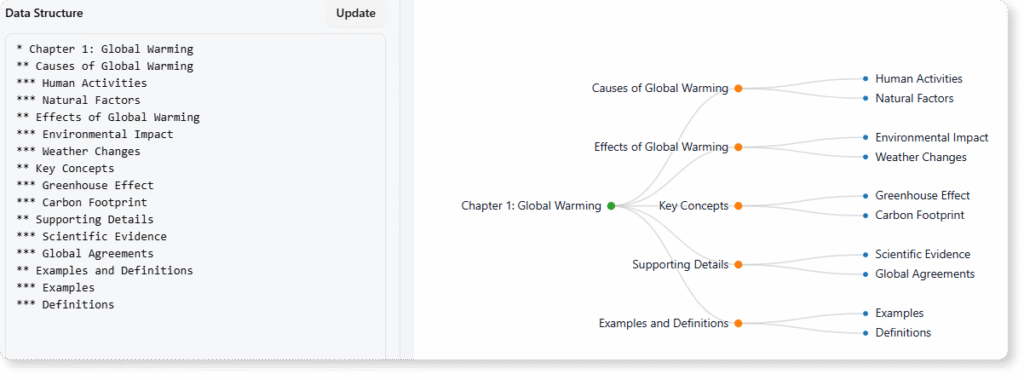AI mind maps have become one of the fastest ways to organise ideas, study complex topics, and plan creative work. Instead of building a mind map manually, you can type a topic, a question, or a rough idea, and the AI automatically expands it into a clear structure. This helps you move from scattered thoughts to organised insights in seconds. Whether you are brainstorming new product ideas, preparing exam notes, or managing personal goals, AI mind mapping gives you a visual space to think more clearly and creatively.
How AI Mind Maps Work
AI mind maps begin with a central theme that you provide. The system then generates related subtopics, breaks them into smaller branches, and builds the first version of your map. You can edit, rearrange, or expand any part of it, but the hardest step—the initial structure—is already created for you. This makes AI mind mapping especially helpful for anyone who often struggles with starting a blank page. Instead of waiting for ideas to appear, you get an instant foundation to build upon.
The benefit is not only speed, but clarity. AI helps uncover angles you may not think of on your own, making your mind map richer and more complete. You can then decide which branches matter most and refine them to match your needs.

Brainstorm Ideas with More Depth and Variety
One of the strongest uses of AI mind maps is brainstorming. For example, if you type in “eco-friendly water bottle business,” the AI can automatically suggest branches covering customer groups, materials, design features, marketing strategies, pricing options, and sales channels. This turns a single idea into a structured exploration of possibilities.
You can then continue expanding the branches, compare options, and identify which directions are worth pursuing. This approach is extremely helpful when working on product development, business planning, or any project where you need to consider multiple angles before deciding what to focus on.
AI mind maps are also effective for creative innovation. They give you unexpected suggestions—features you may not have considered, potential challenges, or niche markets that spark new insights. This makes brainstorming more productive, especially when you need to generate a large number of ideas quickly.

Build Clear, Condensed Study Notes for Exams
Mind mapping is a proven study technique because it helps you understand relationships between concepts. With AI, you can create a full set of study notes in minutes. For instance, starting with “Photosynthesis,” the system can break the topic into definitions, the chemical process, stages, diagrams, exceptions, and common exam questions.
This turns a large chapter into a single visual page that you can review more easily. You can attach key formulas, textbook notes, and your own explanations directly to each branch. The result is a personalised and structured summary of what you need to learn.
AI mind maps work well across academic subjects. Science topics benefit from visual breakdowns of processes, while humanities subjects gain clarity from organising historical events, literary themes, or case comparisons. Revision becomes much faster because the map shows the entire topic at a glance, helping you quickly identify which areas require more practice.
Shape and Plan Creative Projects
Creative work often starts with loose ideas that need to be sharpened into a clear structure. AI mind maps provide that structure instantly. For example, if you are planning a short film, you can begin with the central theme and let the AI generate branches for plot ideas, character development, visual style, production notes, sound design, and scene structure.
Seeing everything visually allows you to strengthen your concept and identify areas that need deeper thinking. You may notice gaps in your story, conflicts that could be more defined, or design ideas worth exploring further. The process works the same for writing stories, building digital art portfolios, planning video content, or organising a long-term creative project.
AI mind mapping also encourages experimentation. You can ask the system to generate alternative directions or versions, letting you explore multiple creative paths before choosing the one that feels right.
Organise Personal Goals and Everyday Life
Mind maps are just as powerful for personal development. When you want to improve your health, learn new skills, manage your finances, or plan upcoming travel, an AI mind map helps break large goals into manageable parts.
For example, starting with “Improving personal health,” the AI can create branches for diet, exercise routines, mental wellness, daily habits, and tracking methods. From there, you can fill in specific steps or schedules. The visual format makes long-term goals easier to understand and follow, because you can see how everything connects.
This method is also useful for career planning, skill development, building new habits, or organising major life events. Instead of keeping everything in your head, you gain a structured roadmap that guides your progress.

Turn Your Mind Maps into Action
AI mind maps are not only for thinking. They can be converted into practical workflows. After completing your map, you can turn branches into tasks, project steps, or presentation slides. A study mind map can become a set of flashcards. A creative mind map can be transformed into a written outline or storyboard. By linking your mind map to the next phase of your work, you turn your ideas into results rather than letting them stay in the planning stage.
Bringing Everything Together
AI mind maps offer a straightforward way to think more clearly, learn more efficiently, and explore creative ideas without feeling overwhelmed. They help you start faster, generate deeper insights, and organise everything visually in one place. Whether you are brainstorming product ideas, preparing exam summaries, planning creative projects, or organising your personal goals, AI mind mapping gives you the structure you need to move forward with confidence.